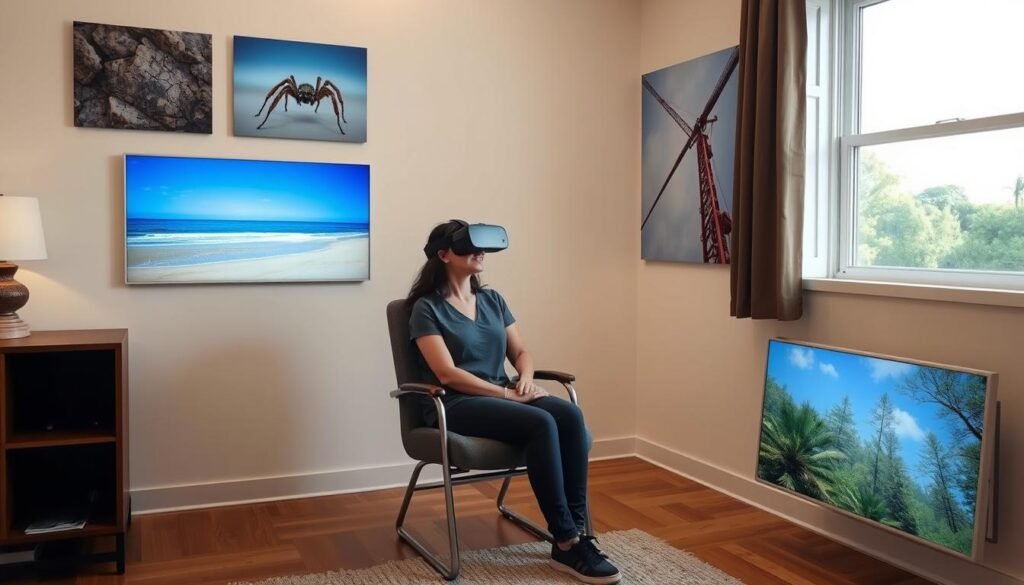Did you know that over 30% of Americans will face an anxiety disorder? This highlights the urgent need for effective treatments. Exposure therapy is one powerful method to help people deal with their fears. It involves gradually exposing patients to the things they fear in a safe way.
This approach is used for phobias, anxiety, OCD, and PTSD. By facing their fears regularly, patients often feel less anxious. This can lead to better mental health and well-being.
Key Takeaways
- Exposure therapy effectively addresses specific phobias and various anxiety disorders.
- The therapy involves gradual exposure to feared situations or stimuli.
- Different types of exposure therapy include in vivo and virtual reality exposure.
- Psychologists have significantly contributed to its development over the decades.
- Organizations like the American Psychiatric Association recommend exposure therapy as a first-line treatment.
What is Exposure Therapy?
Exposure therapy is a way to help people face their fears. It plays a big role in treating psychological problems. The definition of exposure therapy includes methods that make patients confront their fears directly or indirectly. This approach helps them get over behaviors that avoid fear, which can make anxiety worse. Gradually, patients learn to face their fears. This reduces their anxiety over time.
There are many ways to do exposure therapy. One method slowly exposes patients to what they fear, helping them get stronger. Studies show that adding cognitive restructuring to exposure therapy helps a lot. For example, the International OCD Foundation found 70% of people with obsessive-compulsive issues see a 60-80% drop in symptoms with this mix.
Exposure therapy works well for many anxiety disorders. These include specific phobias, generalized anxiety disorder (GAD), and social anxiety disorder. The Psychiatric Times reported a study where exposure therapy cut anxiety by 90% and phobia symptoms by 65%. Plus, prolonged exposure therapy is very effective for PTSD, especially from combat.
The long-term benefits of exposure therapy stand out. Over 80% of PTSD patients still see benefits six years after treatment. In vivo exposure therapy works in over 80% of phobia cases. That shows its value in psychological treatment. Adding relaxation techniques, like breathing exercises and mindfulness, helps too. They help patients control stress and emotions while getting treatment.
The Importance of Exposure Therapy in Anxiety Management
Exposure therapy is key in managing anxiety. It helps individuals face their fears safely. This process reduces the fear and avoidance cycle common in anxiety disorders.
Many studies support exposure therapy’s success. People often experience reduced anxiety after treatment. Beyond lowering symptoms, it boosts confidence. This confidence helps patients face new challenges without fear.
Exposure therapy strengthens emotional toughness. It helps break down negative connections through habituation and extinction. Patients learn coping skills through in vivo and imaginal methods, improving mental health.
- Addresses multiple anxiety disorders: exposure therapy is effective for conditions such as phobias, panic disorder, and social anxiety disorder.
- Promotes gradual desensitization: the pacing of the therapy allows individuals to approach fears incrementally.
- Encourages positive outcomes: studies show that patients frequently experience significant improvements in their symptoms.
Exposure therapy is crucial in anxiety treatment. It empowers people to manage their anxiety better. They enjoy improved life quality as a result.
| Condition | Effectiveness of Exposure Therapy |
|---|---|
| Phobias | 90% reduction in fear and avoidance in specific cases |
| Panic Disorder | Better maintenance of treatment gains compared to medication |
| Obsessive-Compulsive Disorder | 86% improvement in symptoms with in vivo exposure |
| Generalized Anxiety Disorder | Proven effective; leads to significant symptom relief |
| Social Anxiety Disorder | Effective in reducing anxiety levels during social interactions |
How Exposure Therapy Works
Exposure therapy uses a step-by-step method to help people face their fears and anxieties. It relies on Mechanism of Exposure Therapy, mainly Gradual Exposure Strategies. Here, patients are slowly introduced to what scares them in a safe setting. This process starts easy and gradually gets harder, letting people get used to it and gain confidence.
Patients also do homework that uses what they learned in sessions. This mix of facing fears directly and learning new ways to cope boosts their ability to overcome anxiety. For example, they learn to breathe slowly and control panic, helping them stay calm when afraid.
Many studies back up how well exposure therapy works for different problems. Specifically, in vivo exposure works well for many phobias, with 80% to 90% of people seeing improvement. Plus, it’s very effective for treating kids, helping in 91% of cases with noticeable progress.
Using behavior therapy with Gradual Exposure Strategies teaches ways to reduce avoiding fears and feeling anxious. It not only helps people handle their fears better but also improves their life. For more insights, check out this article. It covers related topics on anxiety disorders.
Types of Exposure Therapy
There are different kinds of exposure therapy, each aimed at various fears and anxieties. Knowing the Types of Exposure Therapy helps people pick the best one for them. Here, we’ll look at the main kinds of exposure therapy.
In Vivo Exposure
In Vivo Exposure means facing what scares you in real life. It’s great for specific phobias, like being afraid of snakes. This method lets people tackle their fears in a safe space, learning to deal with anxiety better over time.
Imaginal Exposure
When facing your fear in real life is hard, Imaginal Exposure steps in. It’s useful for fears like needles or blood. People imagine their fears in a supportive setting, helping them confront and manage their anxieties.
Virtual Reality Exposure
With Virtual Reality Exposure, tech creates close-to-real situations. It’s good for people who can’t face fears in real life. This approach helps them face traumatic memories, like war, in a virtual world. It helps gain control over their anxiety.
Interoceptive Exposure
Interoceptive Exposure is for dealing with panic disorders. It makes people feel anxiety-like physical sensations on purpose. By doing this, they learn to understand and handle their fears. This method helps lessen anxiety and gives a feeling of control back to the individual.

| Type of Exposure Therapy | Description | Best Suited For |
|---|---|---|
| In Vivo Exposure | Direct confrontation with real-life fears | Specific phobias (e.g., fear of snakes) |
| Imaginal Exposure | Confronting fears through imagination | Fears difficult to recreate physically (e.g., needles) |
| Virtual Reality Exposure | Simulating realistic scenarios with VR technology | Traumatic memories (e.g., wartime experiences) |
| Interoceptive Exposure | Inducing physical sensations to reduce panic | Panic disorders |
Choosing the right type of exposure therapy is key. Each method has its own benefits for dealing with anxiety. They offer ways to face and overcome fears, leading to better mental health.
Exposure Therapy: Reducing Anxiety and Depression Through Gradual Exposure
Exposure therapy is key in reducing anxiety and boosting depression treatment. It helps people face their fears in a safe space, using gradual exposure techniques. This approach allows them to do things they were scared of, improving their mental health.
It also helps change how people think about scary situations, making them stronger emotionally. By facing their fears more and more, their fear response gets smaller. For example, someone afraid of speaking in public can start with small groups and slowly move to larger ones. This technique reduces their fear and improves their mood.
Many research studies show that exposure therapy works well for different disorders like social anxiety and panic attacks. It can make a big change in someone’s mental health. This has been proven by research showing people overcoming their fears. Despite its benefits, it’s not used enough in treating patients, as noted in an article.
| Exposure Type | Description | Common Uses |
|---|---|---|
| In Vivo Exposure | Direct exposure to the feared object or situation. | Phobias, OCD |
| Imaginal Exposure | Imagining the feared situation in a controlled environment. | PTSD, trauma |
| Virtual Reality Exposure | Using VR technology to simulate exposure scenarios. | Social anxiety, specific phobias |
| Interoceptive Exposure | Exposure to bodily sensations associated with anxiety. | Panic disorder |
Exposure therapy offers a powerful, evidence-based way to fight anxiety and depression. Through gradual exposure techniques, people can find new paths to a happier life. It helps them face their fears and improves their emotional health.
Applications of Exposure Therapy in Phobia Treatment
Exposure therapy is a key method for tackling various phobias. It significantly lowers anxiety and helps people face their fears. Gradually, patients are introduced to what scares them. Through this, they learn ways to cope and reduce the symptoms related to their phobias. This therapy is quite helpful for specific phobias, social anxiety, and panic disorders.
Specific Phobias
Exposure therapy works well for specific phobias, like the fear of heights or animals. Research shows that through Phobia Treatment, people see a major drop in symptoms. Many even find the improvements last well beyond the end of their therapy. It highlights how cognitive behavioral therapy (CBT) effectively works alongside exposure techniques.
Social Anxiety
With social anxiety, Social Anxiety Therapy can include exposure therapy. It lets people face social situations in a safe way, helping them get used to such events. This builds confidence and reduces the fear of being judged. While medicine like SSRIs might be used, the main focus remains on tailored exposure exercises.
Panic Disorder
Panic disorders come with intense fear that can take over a person’s life. Panic Disorder Solutions use exposure therapy to face these fears in a secure environment. Starting with less intimidating situations and moving to harder ones helps people become less sensitive to panic triggers. This restores their control over their responses.
| Phobia Type | Treatment Effectiveness |
|---|---|
| Specific Phobias | High success rates reported, especially with CBT integration |
| Social Anxiety | Effective when combined with gradual exposure techniques |
| Panic Disorder | Desensitization leads to improved symptom management |
In summary, using exposure therapy in Phobia Treatment is proven to work for different anxiety disorders. It helps people become stronger and brings lasting positive changes for those struggling with anxiety.
Gradual Exposure Strategies in Therapy
Gradual exposure strategies are key in effective therapy. Therapists use a step-by-step approach to help people face their fears easily. A main part is creating a fear hierarchy. This list orders fears from least to most scary, making it easier to tackle them one by one.
Therapists use behavioral techniques like graded exposure and systematic desensitization. These methods help control emotions during therapy. With graded exposure, they start with easier situations. This builds confidence before moving on to harder ones. It makes sure clients aren’t too stressed, creating a safe place for growth.
Studies show that gradual exposure works well. For specific phobias, success rates are between 60% to 90%. This proves that using a fear hierarchy really helps in treating anxiety disorders.
The benefits of exposure therapy last a long time. People often see improvements continue after treatment. Research shows those treated for phobias feel better long-term. This emphasizes how gradual exposure can cause lasting change. For more details on this therapy, check out this study.
Combined Therapeutic Interventions with Cognitive Behavioral Therapy
Mixing Cognitive Behavioral Therapy (CBT) with exposure therapy is a strong way to treat anxiety disorders. This combo lets clients face their fears and rethink the wrong beliefs behind those fears. With Combined Interventions, experts help clients understand their thinking better, making therapy more effective.

Exposure therapy is key in CBT, focusing on actions that make people face what they usually avoid. Through different activities, patients slowly face their fears, which helps reduce avoidance. For those with panic disorder, CBT tackles the big issue of seeing their symptoms as catastrophes.
Generalized anxiety disorder (GAD) shows why combining therapies is crucial. This condition makes people worry a lot about many things. The therapy uses mind and action strategies. It helps people question their worries and gently face what makes them anxious.
Social anxiety disorder brings its own hurdles, like the fear of being judged negatively in social places. CBT for social anxiety has two steps. This helps people slowly deal with their fears of social situations.
| Type of Anxiety Disorder | Cognitive Characteristics | Behavioral Focus | Possible Resistance to Treatment |
|---|---|---|---|
| Panic Disorder | Catastrophic misinterpretations | Exposure to panic triggers | 10-30% do not respond |
| Generalized Anxiety Disorder | Excessive worry | Engagement with various fears | Variable responsiveness |
| Social Anxiety Disorder | Fear of negative evaluations | Gradual social exposure | Resistance to social engagement |
Even though exposure therapy works well, up to 30% of clients might not benefit as hoped. It’s suggested that we find better ways to make therapy success rates higher. Studies support the mixed approach for treating anxiety and helping patients. For more info on these methods, you can read more here.
Evidence-Based Approaches to Exposure Therapy
Exposure therapy is a key treatment for many anxiety disorders. Studies support its Exposure Therapy Effectiveness, especially for phobias, panic disorder, and PTSD. It’s based on evidence, showing how it works and the benefits it brings.
Research Supporting Exposure Therapy Effectiveness
A lot of research proves exposure therapy’s success for various anxiety issues. For phobias, over 80% of patients saw improvements. Single-session treatments also led to a 90% reduction in fear for these patients.
When it comes to OCD, 86% of people improved with exposure therapy, while only 48% did so with medication. These numbers highlight how effective this therapy is.
Long-term Outcomes of Exposure Therapy
The benefits of exposure therapy don’t just fade away. Many see a decrease in symptoms long after treatment ends. For PTSD patients, over 80% still felt better six years later. This shows the lasting impact of Evidence-Based Approaches and the importance of exposure therapy in managing anxiety.
Studies are diving into why exposure therapy works so well. They’re looking at habituation and self-efficacy among other things. This research is making sure more people can get the help they need from this powerful therapy approach.
| Disorder | Improvement Rate | Long-term Benefits |
|---|---|---|
| Specific Phobias | Over 90% fear reduction | 80% maintained improvement after 6 years |
| Panic Disorder | 32% maintained gains at 6-month follow-up | Long term improvement noted |
| OCD | 86% improvement vs. 48% with medication | Sustained improvements reported |
| PTSD | 80% showed continued benefits after 6 years | Significant reductions in symptoms |
Getting Started with Exposure Therapy
Starting Exposure Therapy is a big step in beating anxiety disorders and phobias. To begin, it’s key to find a therapist who knows about exposure techniques. A therapist with a focus on exposure therapy can offer the right help and a plan shaped for your needs.

Look for therapists in professional groups. It shows they’re committed to quality care. Methods like in vivo, imaginal, and virtual reality exposure can help. Each one has its benefits for facing fears safely.
An in-depth assessment will help choose the best method for you. Techniques such as graded exposure or systematic desensitization can ease you into facing fears. You might see improvements in confidence and how you handle emotions. This can bring lasting positive changes.
| Technique | Description | Effectiveness |
|---|---|---|
| In Vivo Exposure | Direct confrontation with fears in real-life situations. | High; effective for specific phobias and social anxiety. |
| Imaginal Exposure | Visualization of feared scenarios to reduce anxiety. | Moderate; useful for trauma-related conditions. |
| Virtual Reality Exposure | Simulation of environments to safely practice exposure. | Effective; suitable for various anxiety disorders. |
| Interoceptive Exposure | Exposure to physical sensations that trigger anxiety. | High; particularly effective for panic disorder. |
Exploring options and working with a knowledgeable therapist boosts your success chances. This approach builds strength and betters anxiety management over time.
Conclusion
Exposure therapy is key for battling anxiety and depression. It lets people face their fears safely, usually reducing their anxiety. This method has proven to work, according to research. Techniques like virtual reality and imaginal exposure offer varied benefits, fitting personal needs. This custom approach helps in dealing with anxiety more effectively.
Knowing how exposure therapy works aids in choosing the right treatment. Different techniques can make therapy better. Getting help from a skilled therapist aids in overcoming fears successfully. We end with emphasis on exposure therapy’s role for better mental health.
The path to manage anxiety needs time and effort, but the outcome is often worth it. It might take weeks or months, but doing exposure therapy exercises regularly helps. We close highlighting how effective exposure therapy can be. It is a good choice for those seeking relief from anxiety.